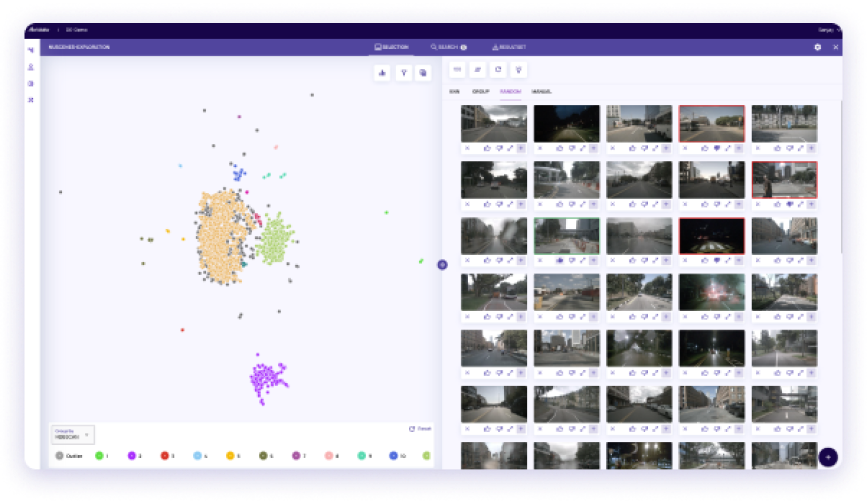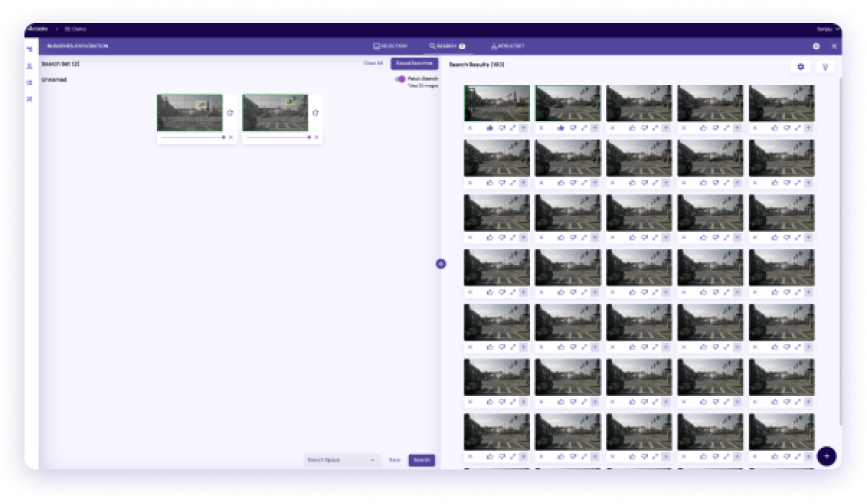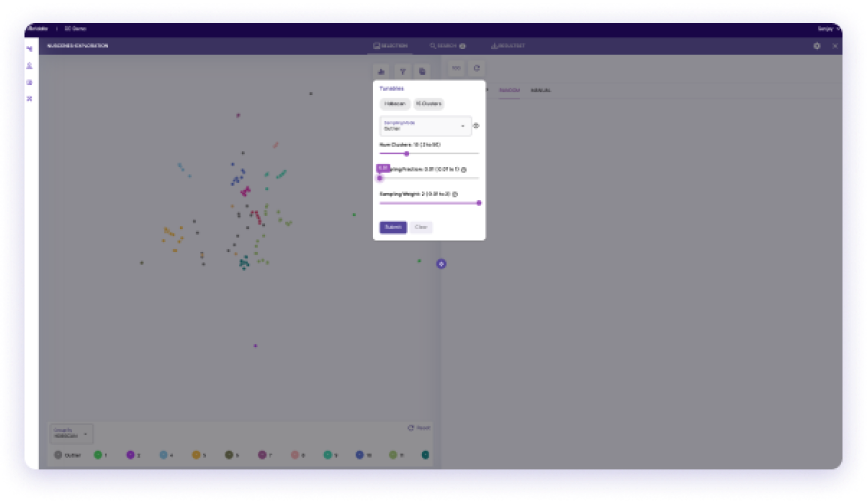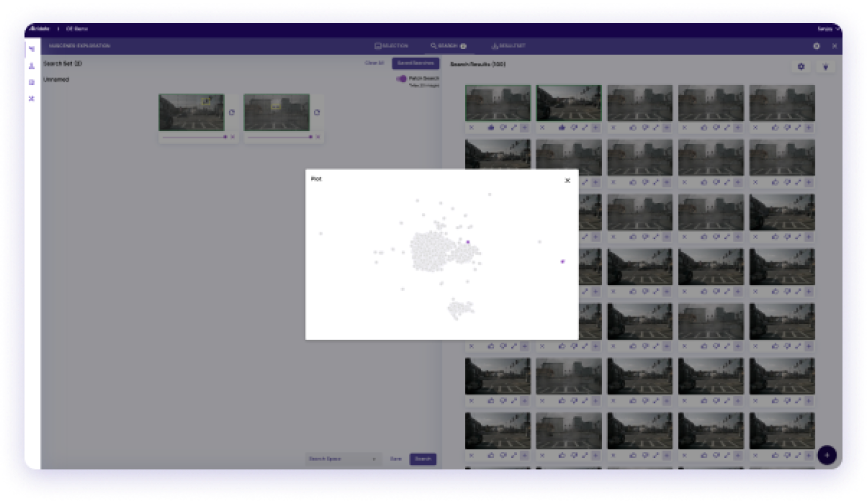Akridata Named a Vendor to Watch in the IDC MarketScape for Worldwide Data Labeling Software Learn More
Efficient Data Curation for AI Model Labeling
Streamline the process of curating and labeling datasets for AI model training with Akridata's Visual Data Copilot.
Automatically sift through large datasets to capture diverse and meaningful samples, saving time and improving model performance.
The Issue
The Challenges of Curating AI Datasets for Labeling
Statement
Sifting through large visual datasets and building effective training sets is a time-consuming and cumbersome process, especially when dealing with video sequences or similar frames.
Description
AI models often require diverse datasets to perform well in real-world scenarios. Video streams, commonly captured at 30-60 frames per second, can produce multiple identical frames, making it difficult to curate the right data efficiently. Traditional downsampling methods may miss valuable information and lead to poorer model performance.
HOW IT WORKS
How Akridata's Data Explorer Simplifies Dataset Curation
Here’s how Akridata Visual Data Copilot helps solve this issue by automating the curation process, ensuring you capture the most diverse and representative data for AI model training.
Step 1 Explore Your Dataset

Step 1 Explore Your Dataset
Get a Holistic View of Your Data
Explore your dataset to understand its variety. Whether it’s traffic lights in autonomous driving datasets or pedestrian crossings in different conditions, Akridata’s tool gives you an overview that helps you start filtering important data right away.
Visualize Key Insights
The Visual Data Copilot allows you to cluster and visualize key images from different scenes, providing an intuitive view of what your dataset looks like and where important edge cases lie. performance.
Step 2 Using Patch Search for Data Labeling

Step 2 Using Patch Search for Data Labeling
Find Relevant Images for Your Model
Utilize the Patch Search feature to identify images that meet your labeling criteria. For instance, quickly locate all frames containing traffic lights or pedestrian crossings, enabling efficient data curation.
Streamlined Data Search
Patch Search ensures that you capture all related frames, including neighboring frames in video sequences, so that no important context is missed.
Step 3 Apply Coreset Sampling

Step 3 Apply Coreset Sampling
Capture the Diversity of Scenes
To ensure your dataset is representative, apply Coreset sampling to reduce the dataset while retaining diversity. This process ensures you are not overwhelmed by redundant data but still maintain coverage of rare and unique instances.
Reduce Dataset Size Without Losing Information
With Akridata, you can reduce the dataset intelligently by selecting only the most valuable and diverse frames, ensuring a smaller but more effective training dataset.
Step 4 Refining Your Results with Patch Search

Step 4 Refining Your Results with Patch Search
Capture the Diversity of Scenes
To ensure your dataset is representative, apply Coreset sampling to reduce the dataset while retaining diversity. This process ensures you are not overwhelmed by redundant data but still maintain coverage of rare and unique instances.
Reduce Dataset Size Without Losing Information
With Akridata, you can reduce the dataset intelligently by selecting only the most valuable and diverse frames, ensuring a smaller but more effective training dataset.
Why Choose Akridata for
Data Curation?
Advanced Dataset Exploration
Visualize your dataset in clusters and explore different groups of images to quickly identify relevant data for labeling and training.
Ensure Dataset Diversity
Capture a diverse range of images using intelligent sampling methods to avoid redundancy and ensure your model is trained on varied data.
Optimize Model Performance
By using curated datasets with representative samples, your AI model will be better equipped to handle real-world scenarios, leading to improved performance and accuracy.
How an Automotive AI Company Curated the Perfect Dataset
An autonomous vehicle company needed to curate and label thousands of images from video streams for training its AI model to detect traffic lights and pedestrians. Using Akridata’s Visual Data Copilot, they were able to reduce dataset curation time by 40%, while maintaining diverse and representative samples. The end result was a more accurate AI model that performed well in varied driving conditions.
Key Outcomes:
- 40% Reduction in Dataset Curation Time
- More Diverse and Representative Training Set
- Improved Model Accuracy by 30%
Features of Akridata Visual Data Copilot
Advanced Dataset Exploration
Visualize your dataset in clusters and explore different groups of images to quickly identify relevant data for labeling and training.
Intelligent Sampling with Coreset
Reduce your dataset size while maintaining diversity with Coreset sampling. Eliminate redundancy and keep the most valuable frames.
Refined Patch Search
Easily locate similar images to streamline labeling for training, ensuring your AI model has all necessary context.
FAQs
Akridata’s Data Explorer streamlines dataset curation through a four-step process: exploring the dataset, using patch search for labeling, applying coreset sampling, and refining results. This automation saves time and ensures a high- quality, diverse dataset.
Akridata offers automated dataset curation, ensuring data diversity and optimizing model performance. Its intelligent tools help select high-quality data, improving the effectiveness of AI model training.
Patch search is a feature in Akridata’s Data Explorer that identifies specific data patterns within a dataset, allowing for more accurate labeling. This enhances the overall quality of the curated dataset.
Akridata uses advanced sampling techniques, like coreset sampling and patch search refinement, to select diverse data points. This ensures the dataset covers a wide range of scenarios, improving AI model robustness.
Yes, by automating dataset curation and selecting diverse, high-quality data, Akridata’s Data Explorer optimizes the training data, which directly enhances AI model performance.
Ready to Simplify Dataset Curation?
Use Akridata’s Visual Data Copilot to streamline dataset curation and ensure your AI models are trained with the best possible data.
